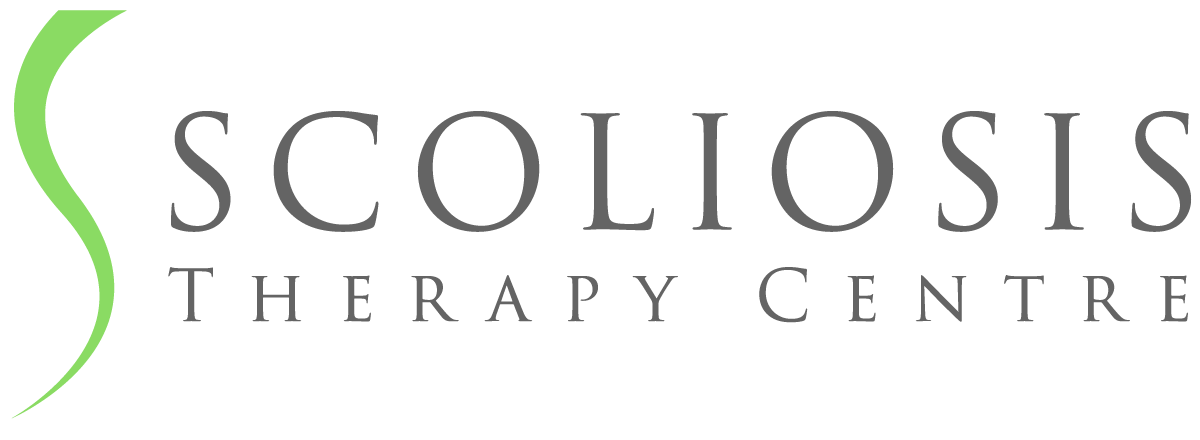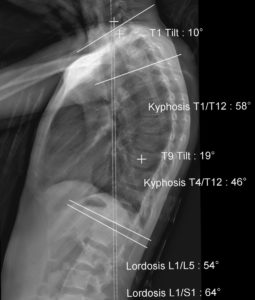According to the Scoliosis Research Society, the normal range of a thoracic kyphosis is considered to be 20° to 45°. Once kyphosis exceeds 45° it is considered to be abnormal; hyper-kyphosis, is typically referred to as “round back” posture.
In the case of Scheuermann's Disease, a juvenile (adolescent) thoracic kyphosis, which occurs at birth, the cause is unknown, but it may be hereditary. Common symptoms include muscle cramps and spasms, pain or stiffness in the back after sitting for long periods, reduced flexibility, or pain when doing activities that require twisting.
Developmental Kyphosis
Thoracic hyper-kyphosis in adolescents, “developmental kyphosis”, results in a larger than normal forward curvature which develops before puberty, a period of increased bone growth occurring in juvenile years and between age 10 to 15. While Individuals may experience pain, they and their parents are more likely to seek medical advice due to concern about the round back posture, and the likelihood of the disorder continuing in adulthood.
The abnormality can take the form of a postural kyphosis - a milder and more flexible condition, or become a rigid, structural disorder - Scheuermann’s hyper-kyphosis. In the latter case, the back becomes stiff due to the wedge shaped development of vertebrae. While scoliosis can also be present with the abnormality, the condition is usually minor.
Definitions of Scheuemann’s disease vary, one being definitive in its diagnosis in that 3 adjacent vertebra must be wedge shaped by 5°; another defines Sheuermann’s disease as a kyphosis of greater than 45° with two or more wedged vertebra [1]
Clinical Charactersistcs of Scheuerman's disease
Clinical characteristics present in cases of Sheuermann’s disease in the thoracic spine include: a posterior shift in the thoracic region; the pelvis moving anteriorly; weight-bearing onto the forefoot; leg axes adjusted anteriorly; a compensatory hyper-extension of the lumbar region; and the head and neck displaced in an anterior position. Tightness in the hamstrings is also a common [1].
Conservative treatment for Thoracic Hyper-Kyphosis
The default treatment for managing thoracic hyper-kyphosis in adolescence is observation. However, once a skeletally immature patient's curvature becomes more advanced, a brace is usually prescribed to stop or even reverse the abnormality.
According to Lowe, brace treatment is almost always successful in patients with kyphosis between 55° degrees and 80°, if the diagnosis is made before skeletal maturity [4] & [5].
Pizzutillo asserts that exercise therapy and practiced corrective sitting and standing are beneficial for adolescents with a postural kyphosis. However, in cases of Scheuermann's kyphosis, Exercise therapy together with bracing is prescribed. Bracing results in a permanent correction of the disorder [2].
In a study published in 2009, 22 girls and 34 boys, with an average of 14 years, diagnosed with either Sheuermann’s hyper-kyphosis or thoracic idiopathic hyper-kyphosis, were treated with the kyphologic TM brace [1], [3], and physiotherapy (exercise therapy), between December 2007 and May 2008.The average in-brace reduction in curvature for the 56 adolescents was 16.5°.
The authors of the study concluded that conservative treatment of Scheuremann’s hyper-kyphosis is regarded as an effective treatment approach; physiotherapy (exercise therapy) and bracing being “first-line” treatments for this disorder. Assuming that the “outcome of brace treatment positively correlates to in-brace correction”, the authors ask the question whether bracing should be the prescribed treatment for growing adolescents before their curvature exceeds 50-55°[1].
The kyphologic TM brace, which is customized for individual patients, is available and supported in Australia.
Lumbar Spine Scheuerman's Disease
Sheuermann’s disease mainly presents as a thoracic spine disorder, however it does to a lesser extent, manifest itself in the lumbar spine. While not as obvious, the lumbar spine disorder is usually more painful, limits movement, and is more likely to continue into adulthood.
Schroth method 3 day intensive hyper-kyphosis programs
Schroth 3 day intensive exercise therapy programs for postural kyphosis and Sheuermann’s kyphosis are conducted by the Scoliosis Therapy Centre, Sanctuary Cove, Qld. for Program format and costs, Click here.
References
Hans-Rudolf Weiss, Deborah Turnbull and Silvia Bohr
Scoliosis 2009, 4:22 doi:10.1186/1748-7161-4-22
[2] Pizzutillo PD: Nonsurgical treatment of kyphosis. Instr Course Lect 2004, 53:485-91.
[3] In-brace corrections in patients with kyphosis using the kyphologic® brace
H R Weiss, M Werkmann, and S Bohr
[4] Lowe TG: Scheuermann's kyphosis. Neurosurg Clin N Am 2007, 18(2):305-15.
[5] Lowe TG, Line BG: Evidence based medicine: analysis of Scheuermann kyphosis. Spine 2007, 32(19 Suppl):S115-9.







